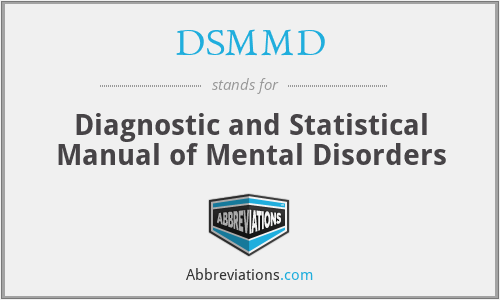What does DSMMD mean in Psychiatry?
This page is about the meanings of the acronym/abbreviation/shorthand DSMMD in the Medical field in general and in the Psychiatry terminology in particular.
Diagnostic and Statistical Manual of Mental Disorders
Translation
Find a translation for Diagnostic and Statistical Manual of Mental Disorders in other languages:
Select another language:
- - Select -
- 简体中文 (Chinese - Simplified)
- 繁體中文 (Chinese - Traditional)
- Español (Spanish)
- Esperanto (Esperanto)
- 日本語 (Japanese)
- Português (Portuguese)
- Deutsch (German)
- العربية (Arabic)
- Français (French)
- Русский (Russian)
- ಕನ್ನಡ (Kannada)
- 한국어 (Korean)
- עברית (Hebrew)
- Gaeilge (Irish)
- Українська (Ukrainian)
- اردو (Urdu)
- Magyar (Hungarian)
- मानक हिन्दी (Hindi)
- Indonesia (Indonesian)
- Italiano (Italian)
- தமிழ் (Tamil)
- Türkçe (Turkish)
- తెలుగు (Telugu)
- ภาษาไทย (Thai)
- Tiếng Việt (Vietnamese)
- Čeština (Czech)
- Polski (Polish)
- Bahasa Indonesia (Indonesian)
- Românește (Romanian)
- Nederlands (Dutch)
- Ελληνικά (Greek)
- Latinum (Latin)
- Svenska (Swedish)
- Dansk (Danish)
- Suomi (Finnish)
- فارسی (Persian)
- ייִדיש (Yiddish)
- հայերեն (Armenian)
- Norsk (Norwegian)
- English (English)
Definition
What does DSMMD mean?
- Diagnostic and Statistical Manual of Mental Disorders
- The Diagnostic and Statistical Manual of Mental Disorders (DSM; latest edition: DSM-5-TR, published in March 2022) is a publication by the American Psychiatric Association (APA) for the classification of mental disorders using a common language and standard criteria and is the main book for the diagnosis and treatment of mental disorders in the United States and is considered one of the "Bibles" of psychiatry along with the ICD, CCMD and the Psychodynamic Diagnostic Manual. It is used – mainly in the United States – by researchers, psychiatric drug regulation agencies, health insurance companies, pharmaceutical companies, the legal system, and policymakers. Mental health professionals use the manual to determine and help communicate a patient's diagnosis after an evaluation. Hospitals, clinics, and insurance companies in the United States may require a DSM diagnosis for all patients with mental disorders. Health-care researchers use the DSM to categorize patients for research purposes. The DSM evolved from systems for collecting census and psychiatric hospital statistics, as well as from a United States Army manual. Revisions since its first publication in 1952 have incrementally added to the total number of mental disorders, while removing those no longer considered to be mental disorders. Recent editions of the DSM have received praise for standardizing psychiatric diagnosis grounded in empirical evidence, as opposed to the theory-bound nosology (the branch of medical science that deals with the classification of diseases) used in DSM-III. However, it has also generated controversy and criticism, including ongoing questions concerning the reliability and validity of many diagnoses; the use of arbitrary dividing lines between mental illness and "normality"; possible cultural bias; and the medicalization of human distress.
Embed
Citation
Use the citation below to add this abbreviation to your bibliography:
Style:MLAChicagoAPA
"DSMMD." Abbreviations.com. STANDS4 LLC, 2024. Web. 25 Apr. 2024. <https://www.abbreviations.com/term/1712430>.



Discuss this DSMMD abbreviation with the community:
Report Comment
We're doing our best to make sure our content is useful, accurate and safe.
If by any chance you spot an inappropriate comment while navigating through our website please use this form to let us know, and we'll take care of it shortly.
Attachment
You need to be logged in to favorite.
Log In